#micro-biology
Explore tagged Tumblr posts
Text
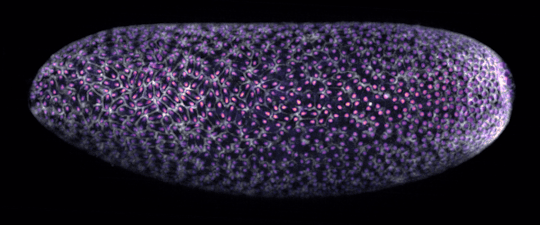
Get Super Up-Close to Biology with the Winners of Nikon’s Small World in Motion
317 notes
·
View notes
Text
Wet Beast Wednesday: tardigrades
Last week on Wet Beast Wednesday I covered the largest animals to ever exist on our planet. This week I'm going to pull a full 180 and cover the smallest animals yet on this series. Meet the tardigrade, the internet's favorite micro-animal the is said to be basically immortal. How true is that? Let's see.
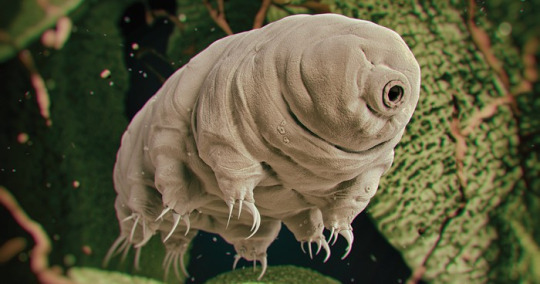
(Image: an electron microscope image of a tardigrade. It looks a lot like a potato with eight stubby legs tipped with long claws. At the front is a small, circular mouth. It has no other discernable features. In the background are bits of plant matter that look like seaweed at this scale. End ID)
The tardigrades are 1,300 known species (and probably a lot of unknown ones too) in the phylum Tardigrada. They are also part of the superphylum Ecdysozoa, which are animals that grow by molting their outer cuticles or exoskeletons. In particular, the tardigrades are believed to be a sister group of the arthropods, the group that contains crustaceans, insects, isopods, and a lot of other things. Tardigrades are truly tiny, the largest species reaching a whopping 1.5 millimeters in length, though most species reach no more than 0.5 mm. They have round, segmented bodies with four pairs of legs that end in either claws or suction discs. The body segments consist of a head, three body segments with a pair of legs each, and a caudal segment with the final pair of legs. The first three legs are used for movement while the final pair points backwards and is used for grabbing onto substrate. All of the body segments except for the final one correspond to segments found in the head section of insects. Tardigrades are missing many hox genes, genes that direct the body plan during development. Their ancestors may have had a body plan more similar to insects, but the loss of the hox genes has compressed them into walking heads with a bit of butt. The mouth is tubular and sucks in food. In the mouth are stylets, needle-like structures used to pierce food objects. Once food is drawn into the mouth, a structure called the buccopharyngeal apparatus activates. This is a combination of spines and muscle that acts like an inner jaw that pulls food into the digestive tract. The buccopharyngeal apparatus is distinct enough to be used as a major identifying feature between species. Tardigrades are translucent and many images you've seen of them have false color to show the details or are 3D models based on scanning electron microscope imagery of them. Tardigrades molt their exoskeletons multiple times (up to 12) during their lifecycle. Some species are unable to poop normally and instead all their waste is discarded during the molt. It was formerly believed that tardigrades could exchange genes with each other without mating, a process called horizontal gene transfer that is seen in bacteria, archaea, and other micro-organisms. It has since been discovered that while still capable of horizontal gene transfer, it is quite a bit rarer in tardigrades than we thought.
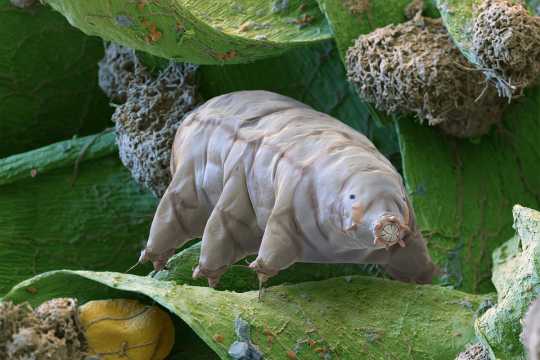
(Image: an electron microscope image of a tardigrade standing on a bit of plant matter. This one has a closed mouth with a ring of triangular tooth-like structures. It also has two simple eyes that look like black dots. End ID)
The name "tardigrade" means "slow walker", which is fitting as, despite their eight legs, tardigrades have a slow and awkward gait. This is the result of their legs being unjointed, only able to pivot at their connection to the body. Their gait has been compared to that of bears, hence why they are often called water bears and their discoverer, Johann August Ephraim Goeze, called them "kleiner wasserbär", meaning "little water bear". Tardigrades are found worldwide and have inhabited virtually every habitat, from the tops of mountains to the deep sea, from hot springs to the antarctic, from freshwater to saltwater. The one thing they have in common is a need to stay wet. Tardigrades can survive out of water as long as they can stay moist and are often found in mosses, hence another common name: moss piglets. The majority either eat plants or bacteria, but some will feed on smaller tardigrades or other micro-animals. Their famous survivability makes it easy for tardigrades or their eggs to be carried to new habitats by larger animals or other phenomena. Tardigrades are one of the first micro-animals to colonize a new habitat and they are a pioneer species, the first species to colonize a new environment and whose presence makes that environment fore suitable for other species to follow. Tardigrades are a major food source to other micro-animals and larger organisms. Most species have distinct males and females, though a few reproduce through parthenogenesis. In most cases, molting female will lay her eggs in her shed cuticle and males will them fertilize them. Other species have a form of internal reproduction. Males and females will court each other before mating and females will usually allow multiple males to fertilize her eggs. Female tardigrades are typically larger and more abundant than males. Eggs can take up to 14 days (species dependent) before hatching. All tardigrades of the same species have the exact same number of cells as each other. They are also born with the same number of cells they will have as an adult. Their growth is driven by enlargement of the existing cells rather than cellular reproduction making new cells. The lifespan ranges between a few months to a few years, depending on species.
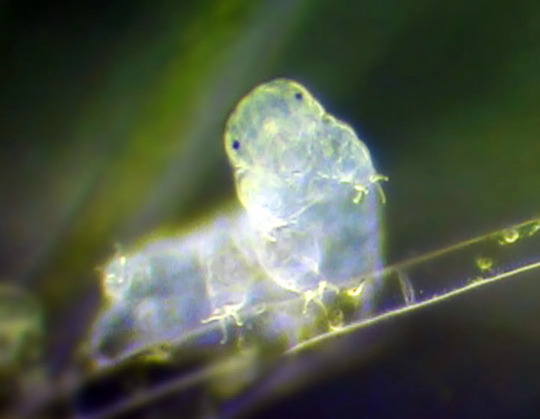
(Image: a color photo of a tardigrade. It is a pale, translucent white, making it hard to make out details. Its body is curved, with the front end pointing at the camera. It has two simple eyes. End ID)
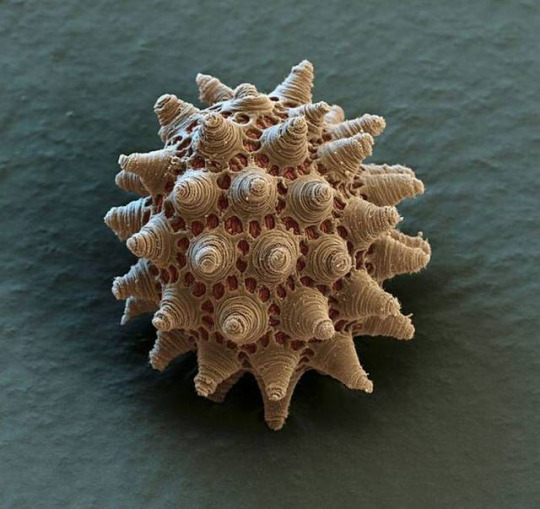
(Image: an electron microscope image of a tardigrade egg. It is round but covered in small pores and conical structures. End ID)
The most famous feature of tardigrades is their legendary durability. It is commonly said that tardigrades can survive just about anything (except for the things that are actually trying to kill them. They are prey to a lot of species after all). Among the things they can survive is extreme heat, extreme cold, dehydration, extremely high and low pressure, exposure to ionizing radiation (that's the scary kind), low oxygen environments, environmental toxins, heavy impacts, and the vacuum of fucking space. While the can survive in extreme conditions, tardigrades are not considered extremophiles. True extremophiles thrive in extreme environments and are negatively impacted by leaving them. Tardigrades can survive in extreme environments, but are negatively impacted and can't survive as well there as they can in less extreme places. The main trait that has allowed tardigrades to survive all five mass extinctions in history is cryptobiosis. Cryptobiosis is the rare ability for an animal to enter a state of dormancy where their metabolic processes come to an almost complete stop. While in cryptobiosis, metabolic activity drops to 0.01% normal and water content drops to 1% normal. In this state, the tardigrade is called a tun. Tardigrades usually enter cryptobiosis in response to arid conditions. One experiment showed that a species of tardigrade could last for at least 30 years in this state and return to normal lifestyle functions when exposed to water. Tardigrades will also enter cryptobiosis in response to low oxygen, toxic chemical exposure, increased or decreased temperature, and excessive salt content in the water. Tardigrades also show extreme resistance to both high and low pressure. They can live in 0 atmospheres of pressure and some species can survive up to 6,000 atmospheres, more than double the pressure at the bottom of the Marianas trench. More interesting is their ability to survive dangerous radiation. They can survive 1,000 times the dose of gamma radiation that humans can. Early tests focused on tardigrades in cryptobiosis and concluded that the extremely low water content of a cryptobiotic tardigrade doesn't leave much opportunity for the radiation to react with the animal. However it was later found that active and fully hydrated tardigrades are still considerably resistant to radiation. Studies into this resistance indicate that tardigrades can very efficiently repair damaged DNA and have unique proteins called Dsup that provides additional protection. Dsup introduced to human cells has provided additional protection against x-rays.
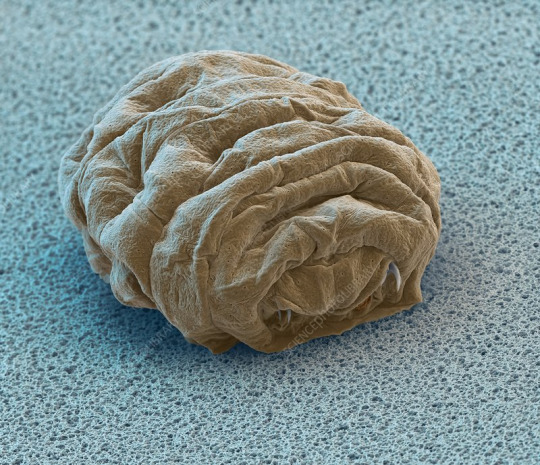
(Image: an electron microscope image of a tun - a tardigrade in cryptobiosis. It is smaller and very wrinkly, with the legs and mouth retracted into the body. End ID)
Tardigrades were the first animals to be exposed to the vacuum of space. They were exposed for 10 days, some in a state of cryptobiosis at the time of exposure and some still active. It was found that they were able to survive the vacuum when shielded from the sun's ultraviolet radiation, with those already in cryptobiosis doing better. Upon being rehydrated, many were able to resume normal life functions and successfully reproduce, though others died after being rehydrated. Those that were exposed to UV radiation fared much worse, with only a few hydrated individuals surviving. The individuals in cryptobiosis had a lower survival rate when exposed to UV than those not exposed to UV and were less successful at reproducing afterwards. Studies of tardigrade's space survival abilities and resistance to radiation could go a long way in helping human space travel. One of the largest dangers of space travel is that space is full of nasty radiation from the sun that Earth's magnetic field protects us from. Some scientists speculate about the possibility of accidentally seeding other planets or moons with tardigrades or other space-resistant organisms. This is a problem because introducing Earth life to other world has the potential to damage any native ecosystems and if we find life in space in the future we don't want to have to figure out if it's something we accidentally put there. While tardigrades could likely survive on other planets, they would eventually die without a food source. Some sources reported that tardigrades may have colonized the moon after an experiment with them crashed. Unfortunately, the moon is not crawling with tardigrades now. It's way too dry for them to exit cryptobiosis even if they survived the crash, which they probably didn't.

(Image: art of a tardigrade floating in the vacuum of space. End ID. Source: University of California - Santa Barbara)
#wet beast wednesday#tardigrade#water bear#moss piglet#micro animal#microbiology#marine biology#biology#zoology#ecology#animal facts#informative#science#space#astrobiology#radiation#cryptobiosis#tun#image described
193 notes
·
View notes
Text
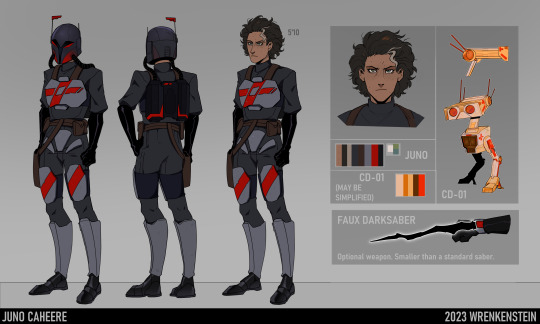
New ref for Juno, hehe! It took forever to make because I wanted her to look consistent and believable, while also making clear her features and details. I think I did well! Granted, I'll probably revisit this later in the year, but for now? It serves its purpose!!
#tech come get your wife#she's microing all over my biology#star wars#mandalorian oc#mandalorian#star wars oc#the bad batch#the bad batch oc#star wars character#i love how grumpy she looks#despite that being unintentional#she's actually such a softie#juno caheere#juntech
184 notes
·
View notes
Text
Scientific reason eggs appear randomly in spinch and why the the comets HAVE SO MANY DAMNED KIDS
(This is a messy uncanon blurb, since God is in fact real on spinch LOL, take this with a grain of salt.
Messy blurb under read more, talks of sex and sexual reproduction
Anthries reproduce closer to plants such as ferns. After puberty each anthry starts producing asexually, they produce these sexual reproducing amoeba.
The amoeba die very quickly and have a low chance of reproduction, which is why casual hang outs you aren't gonna have babies.
Long time partners have an increase chance of making children. (Friend, fwb, partners, qprs, etc)
Anthry sex creates more strong amoeba and encourages more sexual reproduction within amoeba.
Take Doolly, the first born. In the hospital due to the amoeba being very weak they die of everything, which is the real reason why no one has kids in the hospital.
Anyways when Doom and Polly are in a safer environment, spend a lot of time together, and even get intimate. The amoeba mate more often.
Finally one of the amoeba lay a fertilized egg and lay it in a warm place. (Let's say a bundle of blankets) they are microscopic at first but grow rapidly. Which is why eggs seem to appear out of nowhere.
Also to prevent inbreeding, amoeba that reproduce with related amoeba almost never succeed bc the egg is too weak to sustain life.
Amoeba usually can tell there related and avoid each other anyways.
What I'm saying is Doom has the most kids bc he's fucking the most and spends the most time with all of his partners.
#quy qries#spec bio#speculative biology#amoeba isnt the best word but shrug#micro organism type thang#sparklecare#sparklecare hospital#cometcare#ask to tag??#pollarydoomi
23 notes
·
View notes
Text

Secrets Hopping
Using a non-destructive, high-res method called diffusible iodine contrast-enhanced microCT (diceCT) to image and digitally dissect the limb musculature of 30 species of frogs reveals relationships between anatomical complexity and function – providing insights that could inform muscle and locomotion research in humans
Read the published research article here
Image from work by Alice Leavey, Christopher T. Richards and Laura B. Porro
Centre for Integrative Anatomy, Cell and Developmental Biology, University College London; Structure and Motion Laboratory, Royal Veterinary College—Camden Campus, Comparative Biomedical Sciences, London, UK
Image contributed and copyright held by Alice Leavey
Research published in Journal of Anatomy, August 2024
You can also follow BPoD on Instagram, Twitter and Facebook
#science#biomedicine#biology#frogs#cells#muscles#locomotion#anatomy#micro CT#digital dissection#3d reconstruction
10 notes
·
View notes
Text
I LOVE BIOLOGY!!!!!
#🔪 - mello talks too much#(basic biology btw)#SO MUC#omhg its so fun i love it so much#micro biology and small stuff not ecology and environmental stuff that shit is lame#BUT I AM SO EXICTED FOR THIS SEMESTER!!!!!!!!!!!#I LOVE GENETICS AND MITOSIS AND THE POLYPEPTIDE MEMBRANE#i hate the citric acid cycle.#I LOVE TRANSCRIPTION AND TRANSLATION AND GENETIC MUTATIONS#I LOVE ENZYMES AND THE LOCK AND KEY MODEL AND ACTIVE SITES AND ALLOSTERIC SITES#guys i am not kidding i am giggling and blushing rn i love it so much omg#(once i get to hard biology i will want to die)
25 notes
·
View notes
Text
Hello! I would like to spread knowledge and appreciation to the micro-animals know as Tardigrades, aka Water Bears, aka Moss Piglets, aka these guys!

They are super cool because they can survive in the most extreme ph, tempatures, acidities, and even SPACE?
They tend to live near water sources, but are found everywhere from rainforests, to Antarctica, to the driest of deserts!
The largest can be up to .5mm, barely visible to the human eye, but they’re also see through so good luck finding one without a microscope.
Anyway, tardigrades are cool.
#tardigrade#water bear#moss piglet#micro organisms#micro animals#I am a tardigrade#immortal little guys#biology#zoology#science#science side of tumblr
21 notes
·
View notes
Text
Sometimes I forget how much shit McCoy canonically knows, at least to a degree of competence. Like ok sure he's not an Engineer or a bricklayer but he's damn well more than "a simple, country doctor"; he's got the sciences badge instead of the medical one for a reason
#like 23rd century be damned#mccoy wears so many medical hats#as well as a decent amount of understanding of biology/microbiology#and i mean. the guy whipped up a whoke cure in Miri with a team of 3 agitated ppl#himself#an old microscope#only spock to immediately bounce ideas off of#and very limited access to ship computers#he formulated a non-lethal fainting formula from ancient materials by hand#so thats chemistry#and back to the (micro)biology—he *was* a genuine option to end out in the immunity syndrome#and swinging back to miri—both pharmacology and virology with a hint of epidemiology#Oh! and he's delivered babies on multiple occasions. no word on if he's particularly trained in gynecology or obstetrics but.#frankly i wouldnt put it past him to be trained in obstetrics and midwifery#like yes a lot of his fields of knowledge are medical#but even in a far future it seems p wild that hes *this* widely competent aross fields like.#physicians are who ppl think of when they hear 'doctor'#and he is a physician#he's just. also. a surgeon. allegedly he is a space psychologist as well#and then see above for grounds to argue he knows pharmacology virology epidemiology and obstetrics/midwifery too#and knows biology and chemistry#no wonder he wanta tk study everything
159 notes
·
View notes
Text
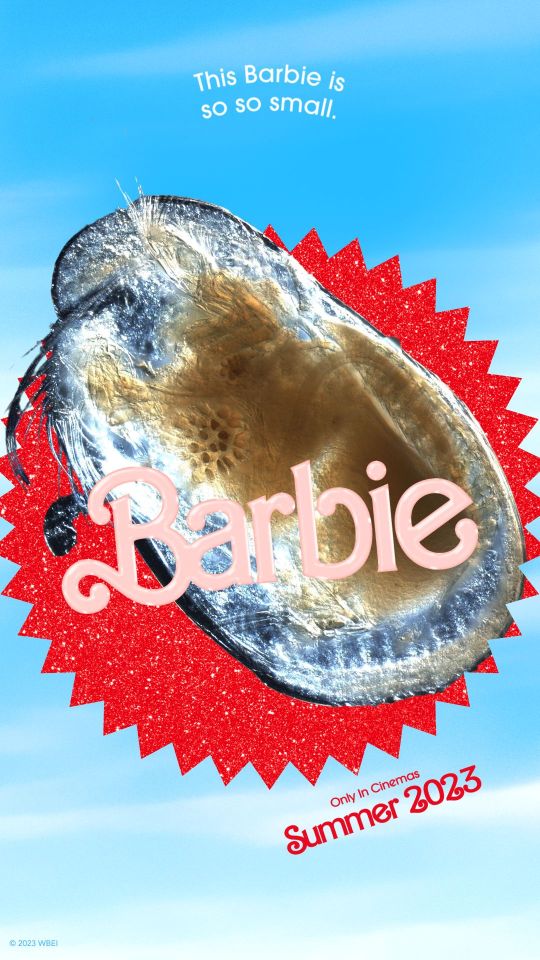
She is the moment.
#paleontology#micro paleontology#biology#shitpost#i love ostracods so much#i have so many ideas for these barbie memes lord (death) help me
134 notes
·
View notes
Text
Unfortunately, I found this poor little thing when it had already passed into the afterlife...

So... Has anyone ever wondered what a wasp looks like under a microscope? 🧐🧐🧐








#microscopy#micro photography#microscope#biology#science#bugs#photography#my photos#nature#mad scientist#Coleopterology#wasp#interesting#the more you know#picture#evgemalia
6 notes
·
View notes
Text

#white leaves#leaves#plant#botanical#w#hite#winter#winter plants#angelic#angel aesthetic#angel#biology#micro photography
3 notes
·
View notes
Text

One cheek cell, 40x
I stained this cheek cell with ink from a random cheap pen, which left blotches all over the slide. The cell absorbed the ink pretty well, especially in comparison to these cells:


I will say I like the light blue stain of the second photo, even though it’s much more difficult to see.
It was fun to see if I could get a nice looking slide with ink from a broken pen, and i’m sure you could if you did everything perfectly. I definitely didn’t, and I’m going to retry these with my methylene blue, which will undoubtedly turn out much better :).

Cheek cells, 40x stained with methylene blue. This slide came out much better!
2 notes
·
View notes
Text


Microscopic View of a Lily Ovary
3 notes
·
View notes
Text
Lab life
go ahead, use the micro pipettes as guns, you know you want to.
#micro pipettes#shooting the little pipette caps into the little bio hazard trash#i had such a fun time with them#very entertaining to “play with” while waiting for the centrifuge#talking about the centrifuge#that shit is scary#heard a story about one of the ones we were using#it got unbalanced and shot it's titanium plate through 3 labs#never touched that machine ever again#it spin#so much#chemistry#biology#DNA sequencing and enhancing#experiments#science is fun
7 notes
·
View notes
Text
"The electric eel is the biggest power-making creature on Earth. It can release up to 860 volts, which is enough to run a machine. In a recent study, a research group from Nagoya University in Japan found electric eels can release enough electricity to genetically modify small fish larvae. They published their findings in PeerJ."
The researchers' findings add to what we know about electroporation, a gene delivery technique. Electroporation uses an electric field to create temporary pores in the cell membrane. This lets molecules, like DNA or proteins, enter the target cell."
"The researchers discovered that 5% of the larvae had markers showing gene transfer. "This indicates that the discharge from the electric eel promoted gene transfer to the cells, even though eels have different shapes of pulse and unstable voltage compared to machines usually used in electroporation," said Iida. "Electric eels and other organisms that generate electricity could affect genetic modification in nature.".
Other studies have observed a similar phenomenon occurring with naturally occurring fields, such as lightning, affecting nematodes and soil bacteria. Iida is very excited about the possibilities of electric field research in living organisms. He believes these effects are beyond what conventional wisdom can understand.
He said, "I believe that attempts to discover new biological phenomena based on such 'unexpected' and 'outside-the-box' ideas will enlighten the world about the complexities of living organisms and trigger breakthroughs in the future.""
continue article
#biology#electricity#eel#electric eel#micro biology#cell biology#genetics#genetic material#energy#charge#discharge#volts#electric pulses#DNA#out of the box#science#breakthroughs#discovery#electric universe
2 notes
·
View notes
Text
Whenever I open my phone my eyes start leaking not even lying
2 notes
·
View notes